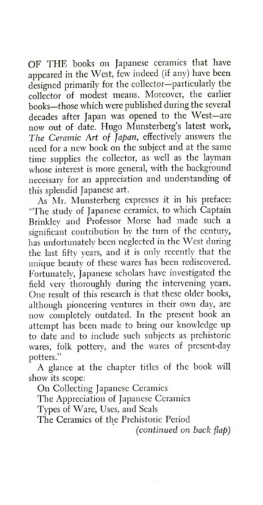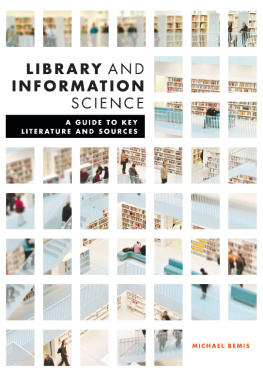A COLLECTORS GUIDE TO BOOKS ON JAPAN IN ENGLISH
The dedicated bibliophile savouring his cherished cache.
Drawn by Kazuya Tomitaka
A Collectors Guide to Books on Japan in English
A select list of over 2500 titles
Compiled and Annotated
by
Joseph Rogala
A COLLECTORS GUIDE
TO BOOKS ON JAPAN IN ENGLISH
First published 2001 by
JAPAN LIBRARY
Reprinted 2004
by Routledge
2 Park Square, Milton Park, Abingdon, Oxon, 0X14 4RN
Transferred to Digital Printing 2008
Joseph Rogala 2001
All rights reserved. No part of this publication
may be reproduced, stored in a retrieval system, or
transmitted in any form or by any means,
without prior permission in writing from the Publishers,
except for the use of short extracts in criticism.
British Library Cataloguing in Publication Data
A CIP catalogue entry for this book is
available from the British Library
ISBN 1-873410-90-5 Case
1-873410-91-3 Paper
978-1-136-63923-4 (epub)
Typeset in Stone 9 on 10 by LaserScript, Mitcham, Surrey
Publishers Note
The publisher has gone to great lengths to ensure the quality
of this reprint but points out that some imperfections
in the original may be apparent.
Dedicated to
Paul Blum, Don Brown
Otis and Frank Cary
book collectors I never met
but whom I encounter
every time I walk into
a rare bookshop
And to my Hitomi
Without whose support
and patience this work
would not have
reached fruition
Preface
T he genesis of this book is rooted in my early years of residency in Hawaii, where I first encountered the culture of Japan. Cultural entities like samurai movies, bon dances, and sushi tingled my senses as my more modest experiences met the exotic.
The collecting of books on Japan began when I spotted Josiah Conders folio-sized Painting and Studies by Kawanabe Kyosai resting in a darkened corner of an antique shop. I was enthralled by the exquisite scroll pictures of tigers, monkeys and birds that Kyosai is famous for and I knew that I must have that book as an addition to my then small collection of older books. Inquiring as to the price of the book, the clerk noted that there was no price listed. I would have to wait for the owner to return before he could quote a price. Impatiently, I insisted that I had to purchase it then and there and that I did not have time to wait. I told him that if he would set a price, I would buy it and be gone. More to get rid of me, I suppose, than anything else, he nervously and somewhat quietly said, Fifteen dollars. Thinking he had said fifty dollars, which was more than I had on me or that I might be willing to pay, I hesitated. I said that that was more than I was prepared to pay for it. Impatiently, he stated that fifteen dollars was as low he would go. Realizing my mistake, I quickly reached into my pocket and paid the man, happy to have acquired my first authentic antiquarian volume on Japan. A few months later, rummaging through a thrift (charity) shop, I found four booklets from the Tourist Library series produced by the Japanese Government Railways. I purchased these for one dollar each. Over the years my acquisitions continued. I acquired a number of fascinating volumes on Japan, some cheaply, others a bit more expensive. My interest in Japan, and in books about Japan, peaked when I met my wife Hitomi. Through her inspiration I made a serious effort to study the Japanese language, history and culture and pursued, almost at fever pitch, the collecting of books until I had, at last, acquired a sizeable collection.
Acknowledgements
I thank all my friends and associates who have assisted me in the making of this book. My special thanks go to Prof. Emeritus Otis Cary of Doshisha University in Kyoto for making available the Cary collection of books housed at Doshisha University of Kyoto - originally owned by his grandfather Otis Cary, and his father Frank Cary, both avid book collectors. My thanks are also due to the staff of the Doshisha University Library whose patience I may have worn thin by asking so many questions and for requesting so many books, but who through it all continued to be helpful, gracious and even smiling.
I am most grateful for the support of the Yokohama Archives of History Library. Available for public use, the library has the Don Brown collection of over 10,000 books, newspapers, magazines and prints as well as the Paul C. Blum collection of 6,000 books. The staff were most courteous and extremely helpful. Also the Japan Foundation Library in Tokyo which, refreshingly, is open to foreigners for browsing and research. Their selection of unusual books is commendable and their staff helpful.
I am especially grateful to Aaron Cohen and Larry Walker for their kind suggestions for improving the content and format of the book. And to numerous others, too many to name, whose input has been invaluable to the completion of this project.
To my wife, Hitomi, is reserved my most heartfelt gratitude for her patience and guidance during the five years of preparation of the manuscript. Her expert advice on content - especially in those distinctive cultural matters privy only to a native of Japan - saved me immeasurable research time and effort. The final production, of course, is fully my responsibility.
I have checked and rechecked the listings for accuracy, yet the task of producing a faultless bibliography is never ending. I hope I have, however, produced a source-book useful to many, now and for generations to come.
JOSEPH ROGALA
Yokohama, Spring 2000
Introduction
W illiam Eliot Griffis, in his introduction to Nitobe Inazos Bushido, noted succinctly that He who would understand twentieth-century Japan must know something of its roots in the soil of the past. As we advance into the twenty-first century, and consider Japans role in the world today and what we might expect from it in the next century, those wise and prophetic words have even more meaning today. A good collection of books will give you the opportunity to better understand the country and its people.
Collecting makes available the resources for a continual study of the country and provides the reader with a variety of different personal and historical perspectives. If your tastes are distinctly visual, you can derive hours of pleasure scanning the pages of illustrations - drawings, etchings, paintings, woodblock prints, photographs, and other skilfully rendered representations - in the books you have collected. Collecting can serve a number of purposes and satisfy many needs, depending on your personality and tastes.













